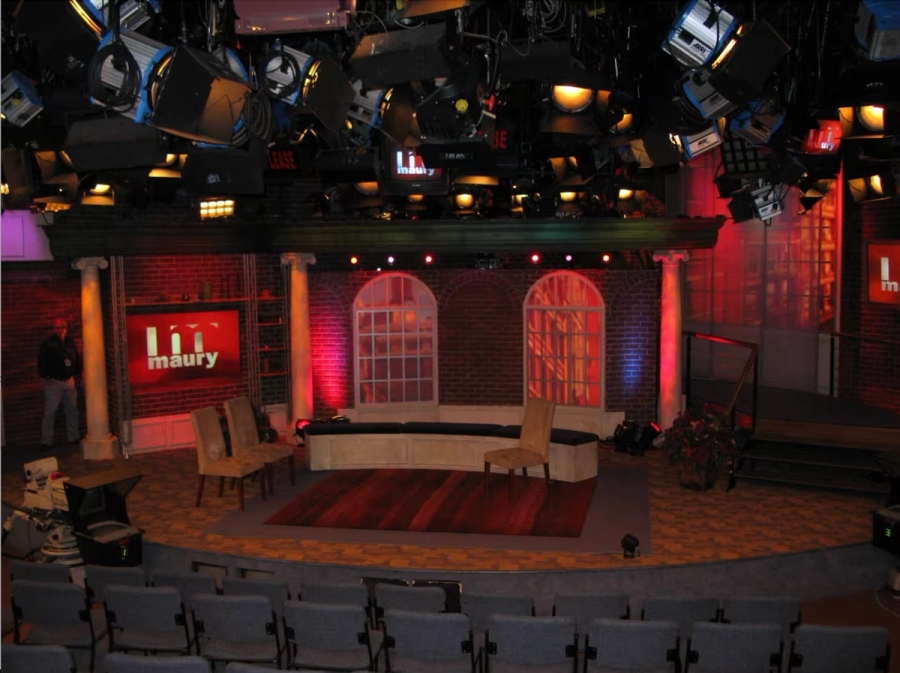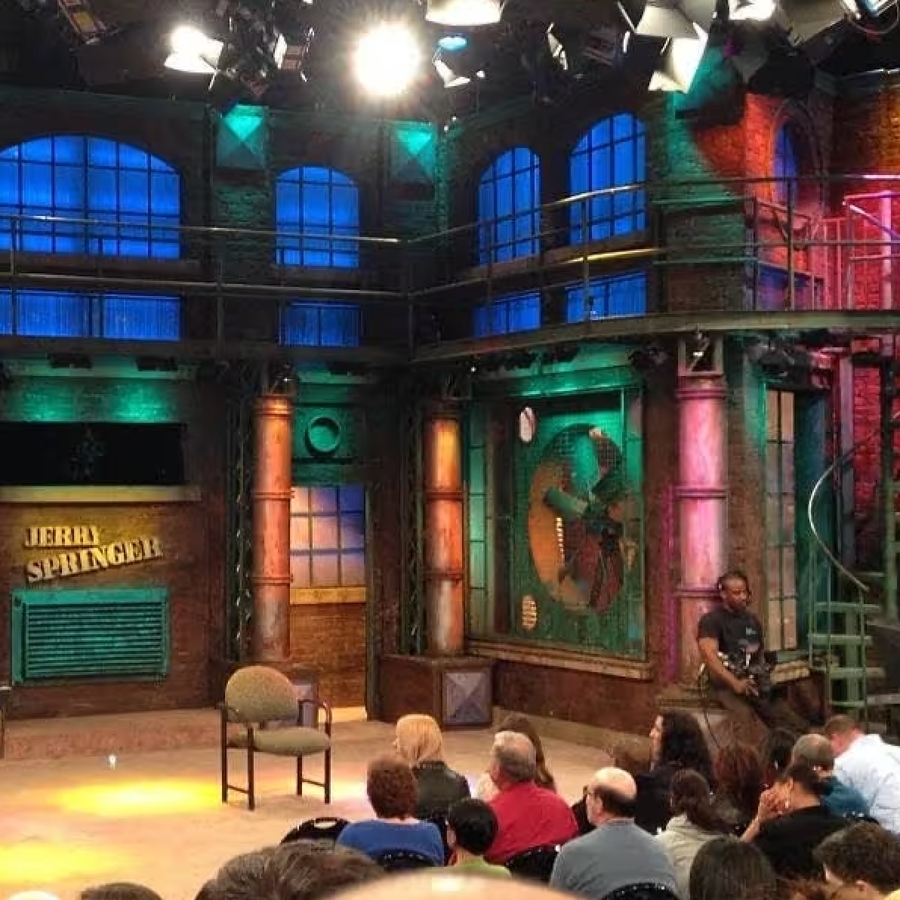Maury! Maury! The Visual Legacy of Tabloid Talk Shows †
Dirt
2022
During one of the 5,545 interchangeable episodes of daytime tabloid talk show Maury—which debuted in 1991 and streamed its last-ever new episodes on NBCUniversal this September—a scuffle erupts between Danny, whose spiked hair impersonates a barreling wave, and Jackie, Danny’s wife in the sweet cardigan and goldilocks curls, after a dubious polygraph test confirms Danny has been unfaithful with 25 women. TV monitors assault the couple from all sides, reiterating the stakes. Each bears the same headline, “NEWLYWED CHEATING,” throbbing against a backdrop the color of hell.
Things get physical fast, as tends to happen on Maury: an amateur WWE match staged in a low-budget living room. Jackie lunges at Danny, who leaps from his seat—a beige high-back dining room chair—and onto a cherry-red area rug. Four security guards hotfoot toward the feud, dodging sparse domestic furnishings. The live audience erupts into gleeful wallops and snickers: waggling fingers and clasping hands to agape mouths. Some stand on tiptoe, hoping for a closer look at the entanglement of limbs, at the maybe-real, maybe-bogus nexus of fury and pain. “I’m taking the test again, in another place!” shrieks Danny. “I’ll take it again! It’s a lie!” As the shot widens, studio windows reveal their dupe views—just fuzzy, placeless printouts of buildings and sky—forcing the audience’s eye away from any external reality, back to the dramatized center of conflict.
Much of the visual grammar of tabloid talk sets—which veered between the dank and industrial (Jerry Springer), or homey and semi-intimate (The Jenny Jones Show, The Tyra Banks Show), each punctuated with overwrought, Disney-esque flourishes—was crystalized on Maury, the genre’s longest reigning, last remaining titan. Decades before the adult-dorm decor of Big Brother and its ilk dominated fly-on-the-wall reality TV, tabloid sets carved their own seductive, distinctive and budget-friendly vernacular, similarly centered on profiting off class alienation by hotboxing participant emotions.
Public moralizing is as old as humanity itself—think the impotence trials of pre-revolutionary France, or early circuses trotting out “freaks”—but tabloid talk sets established a copy-paste format for it to be streamed en-masse. Often isolated on stage and only filmed in short, dramatic bursts, its guests are stripped of nuance: they become a cheater or a partner wronged, awaiting the puritanical judgment of an audience obsessed with adultery.
Though the staging at Maury’s New York, then Connecticut studio shifted over the decades, it remained close to production designer David Weller’s 1991-2009 vision: the skeletal approximation of a family home-cum-90s highway chain restaurant, a vaguely domestic foil to sporadic outbursts of violence. Its few materials attempted to generate warmth, but still came off tacky-corporate: exposed faux brick walls; imitation wood flooring; a plush, generic rug. Four artificial marble columns—a theatrical flourish alluding to order and civility, and to domestic spaces as sites of theater—pretended to hold up the studio ceiling.
The stage’s freestanding centerpieces—a suite of tall, plain-upholstered dining chairs—were lightweight enough to double as weapons. Sans table, they seemed deliberately awkward and out-of-place, their exposed sides leaving guests vulnerable to attack. Often spaced too-far apart from each other, and reconfigured with musical-chairs speed between shots, Maury’s seats spawned a jarring, distancing effect between subjects and viewers. Each guest, even Povich, is alienated, like a late arrival to a group dinner who’s forced to sit on a too-high barstool, physically out of sync with their surroundings.

An empty Maury studio. (Flickr)
The sensationalist roots of Maury—and of other daytime tabloid or “trash” talk shows—lies in late-night 60s programming, namely The Les Crane Show, which platformed rousing, oppositional political figures like Malcolm X and segregationist George Wallace. (In 1964, Crane asked gay rights activist Randy Wicker about life as an openly gay man, the first televised interview of its kind.) By the 80s and early 90s, at peak viewership, the genre’s content had mutated into something much slicker and meaner: a ravenous, churning apparatus fixated with identity politics, busted taboos and social deviance, monetizing Reagan’s culture wars. More than a dozen pulpy productions streamed through the sunlit hours, all christened in homage to their “straight-shooting” hosts: Geraldo, The Oprah Winfrey Show, The Jenny Jones Show, The Mark Wahlberg Show, The Marsha Winfield Show. Each one crawled over its subjects, writes media theorist John Caldwell in the 1995 tome Televisuality, “like a ravenous semiotic machine.” The punchlines of tabloid print are repackaged as “endlessly mutating video wallpaper.”
On Maury, for instance, we witness “finite permutations of a limited iconography” (to borrow a line from Dave Hickey on fixed-outcome poker machines). Alongside recurring paternity test storylines streamed a flattened parade of deadbeat dads, feuding families, pregnant teens, trans people and gender non-conforming individuals, guests with shameful-but-twee fetishes and addictions, and cheating partners engaging in lurid trysts, all framed as scatalogical freak-show fodder for stay-at-home America. (The show’s guests were reportedly unpaid, but flights, meals and hotels were booked soon after they called Maury’s hotline, with allegedly little fact checking to verify stories. The end-to-end process was a high-speed blur, already over before any amped-up participants might regret their involvement.)
If Maury’s stage cast its subjects as upenders of domestic normalcy—outcasts chucking chairs across The Great American Living Room in scenes ripe for a campy Lil Nas X parody—then Jerry Springer was more overt in its doomsday religiosity, depositing the poor, the marginalized, the kinky, and fame-hungry inside its cavernous industrial inferno to burn (a)live.
Springer launched in September 1991 as a bootleg Phil Donahue, trailing Maury by just a few weeks, and in early seasons, when content was slightly more tepid, its stage embodied the genre’s faux decorum. The first set was bare bones and forgettable, with a washed-out hospital palette. It was soon replaced by something more Ricki Lake (read: youthful, personable), equal parts family room, comedy cellar, and Irish chain pub. Bottle-green carpet met brick-and-green carpeted walls (the greens so similar in hue that wall and ceiling coalesced, forcing a claustrophobic relationship between subjects and audience); two largely empty bookshelves (above which the original Jerry Springer logo sat); a flower vase; and guest chairs in handsome wood and green upholstery, the kind one might pair with a legal lamp. (As with Maury, Springer’s chairs were narrative tools, a means to gauge the emotional tenor between guests. Their endlessly shifting placement—and occasional removal from stage—exaggerated alliances and rifts. Springer, the self-appointed ringmaster who’d later become Judge Jerry, usually paced to and fro in his suit, as though above all that mess.)

The Jerry Springer set (YouTube).
Pre-2000s, when the Springer stage attained its peak form—a sweaty, subterranean club with dazzling theme-restaurant lighting and a two-story stripper pole—the show was already integrating judgment-day cues. Take the episode “Sizzling Lesbian Sex Scandals.” The title appears over a wide shot of Springer’s ecstatic, fist-pumping live audience, whose thunderous, synched chants of “JERRY! JERRY!” mutate into a sonorous, animalistic barking. Springer enters mid-congregation, as tabloid hosts were prone to do, his face assuming the requisite empathy of a crooked televangelist. “Today, we’re talking to women who say they’ve been secretly cheating on their lovers. They’re here to finally reveal their sizzling, sexy secrets. Please meet Shell, who says she can no longer hide her three secret lovers.” Springer pivots to Shell, grinning: “So you don’t know how to juggle!”
Later, hyperbolic theatrics ensue: the women wrestle, smudging lipstick; security peels furious skin off skin; someone hollers “Close your legs!” to audible guffaws; a step-sister reveals her involvement in the tryst; and Shell admits she’s secretly engaged to a man, underscoring the show’s heteronormative bias. (“How could I be faithful to a woman?” she asks.) At the installment’s close, before he shakes participants’ hands like a campaigning politician, Springer delivers his “Final Thought” to camera. It is a teaching moment designed to emphasize both Springer’s “progressive” values (he was a former advisor to Robert F. Kennedy, former Mayor of Cincinnati, and one-time Democratic nominee for Governor of Ohio), and the stacked chasms of class and ethics and privilege that separate him from the show’s subjects, who’ve simply gone too far. “Being bi doesn’t permit you to pass by the dictates of fidelity,” lectures Springer, positioned before a brick wall and a washed-out canvas abstraction. “‘Till next time, take care of yourselves and each other.”
The implicit promise made by tabloid talk shows is closeness: a greater proximity to “real” people and the unfiltered chaos of their private lives. A generous reading might suggest that in watching these programs we can better understand the actions and reactions of others, or perhaps recognize and begin to untangle the wilder, thornier proclivities buried within ourselves. That, of course, is a falsity: the nature of much American spectacle, even now, is that it functions as a bait and switch, promising authentic connection while alienating, flattening all it represents. The sets of each program—erected with what appears to be a strip-mall budget and hastiness—wryly nod to the content’s inherent emptiness, like a punchline reveal.
That Maury, Jerry Springer, and Steve Wilkos would eventually be taped in the exact same Stamford studio hall—thanks to the lure of a hefty Connecticut tax credit incentive—is not surprising. Nor is the fact that their three-in-one studio build was rushed, taking only 10 weeks. Or that between show tapings, an overhead crane would switch out backdrop centerpieces, and a new stage would materialize over the course of three hours. Set designers and lighting experts would transition, say, Springer’s grimy underworld—all exposed pipes and whirring industrial fans, its flooring now concrete, not carpet—into the joyless prison yard that is The Steve Wilkos Show, which is hosted by an ex-Chicago cop and longtime Springer security guard, and where troubled guests enter via a hulking cartoon-evil door, a swinging stack of cinder blocks. Next taping: Maury’s stagelit salon, with its shelves of fake orchids and candlestick holders and flowerless vases, and its classical Cheesecake Factory columns, which look almost romantic when drenched in gelled blue lights.
Sometimes, before Maury and Springer ceased filming, guests from one show would run backstage—to weep or scream or hyperventilate—and the propping from another production would creep into the frame, like organs bared. This never seemed to bother producers. Perhaps they didn’t care about the already tenuous authenticity of their spectacle. Perhaps it really didn’t matter, as every show was so alike. The fizzling genre is so marked by its collapsing of detail—binge it for long enough and “characters,” plotlines, and traumas meld into an unending, one-dimensional blur—that it was, for a moment, a multiverse unto itself: a simulacral theater-cum-dining room where no one ever ate, just informed us they were hungry, starving, to thunderous applause.
dirt.fyi/article/2022/10/maury-maury